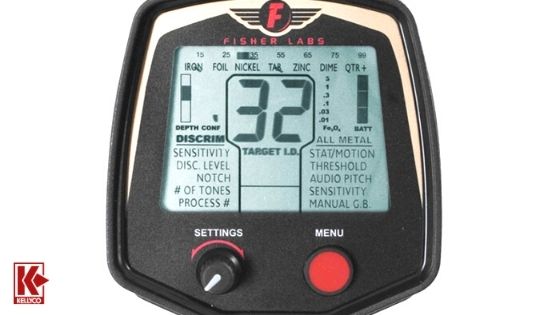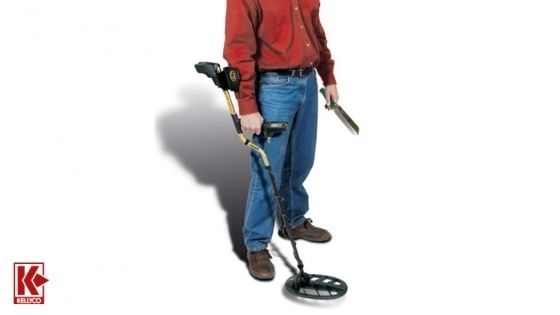Field Test: Fisher F75 Metal Detector Review
Published by Jenna Anderson on 08/06/19

Fisher F75
To begin I’d like to explain a little about why I wanted to write a review of the F75. My first detector was purchased by my wife in 1980. As most well know, the machines back then, had very little depth and hardly, if any, discrimination. Since that time I’ve owned three other detectors from two different manufacturers, not to include my present FisherF75. Being a procrastinator, (in the biggest way) I\’d dragged my feet for over a year before choosing the F75. I had read every article and review that I could find before my purchase in March of 2009.
After buying the machine from Badger Metal Detectors (Gene Scullion) I was extremely excited when it arrived. One note worthy quote that Gene stated after I bought the F75 was “you won’t look back.”
This was because he was using the same machine that I was prior to switching to the F75. Nope, I never looked back. I could hardly wait to try it out in my test garden where I had many different coins and trash buried at different depths. Now you might be wondering why I was so excited about the test garden. Well, to be truthful, it was because many of the coins had vanished from detection by the other machines I had been using.

Settings In Default
Practically running out of the house to the test garden, and knowing the dime was the smallest coin planted there, I had to try it first. My anticipation and excitement was high when I turned on the machine for the first time. I left all of the settings in default and swept over one of the undetectable dimes and “BAM” the F75 acquired the dime with no problem. I could not believe what I was seeing for a few moments. The dime was lying flat at only 6″ deep. I was well pleased and my confidence was high from the very start. As I moved to the other hidden targets they were also easy to detect. Each gave away their location with very little effort on the part of my new machine. Now, a little history about the garden will help to understand my feelings. About two years prior, I had planted the garden without cleaning out all junk and iron targets first. It just so happened, the area was riddled with nails and other typical barn yard material. Shortly after burying the targets, a couple of good soaking rains had caused some of the coins to vanish from detection (by my other machines).
With my confidence high I headed out to the areas where the other machines had given me so much trouble in the past. My first stop was a local community center where I had found a silver dime about a year before. There’s also a story about this dime as well. It was only 2” deep and laying flat. The machine that I was using at that time was not a slouch (I had dug nickels at 7+” before), but was actually one of the best relic machines around, but it only gave a very low volume beep over this target. Thinking it had to be a deep target I dug a 6″ plug just to find the dime in the top two inches of dirt. This particular find got me to thinking about why the machine only gave a faint signal. At that time I really didn’t think masking was a factor in the areas where I hunt so I sent the machine in for a tune up because of the very low volume beep on the dime. Two weeks later, the machine came back with a clean bill of health, but I have not forgotten that day. I really felt the area should have more goodies, but couldn’t seem to acquire them with the other machines. Well, anyway, I returned to the same area where I had hunted with the other machine, and within a couple hours had 2 silver dimes, 1 silver war nickel and 2 wheat pennies, not counting the regular clad coins.
A few days later I had an opportunity to hunt at an old school that had been shut down for about 40 years. This is where the F75 proved to be a superior coin and relic hunting machine. This area was covered with old rusted nails and miscellaneous metal parts. Hunting was more difficult because of the many targets in the ground but three hours later yielded 2 Indian head pennies, 1 wheat penny, two buffalo nickels and an antique green stone ring. At this site I was utterly amazed at how fast the machine could sound off on the different targets. I remember getting a good signal, pinpointing what I believed to be a good target and after digging a nice plug 5″ deep only to recover numerous nails from the same hole. All the time thinking I had heard a good target for sure, I continued to dig until the Indian came to light. Then I stopped and thought for a moment about what I had just witnessed. There were at least 3 nails in the same hole where the penny was, talk about iron see through, the F75 saw the penny through the rusty nails.
After a couple weeks of successful hunting I decided to head out to one of the local schools to do a little coin shooting. Okay you might say, “What’s the big deal with coin shooting”, Oops! here comes another story. This particular school has the most difficult ground in my area to metal detect. I have hunted it for several years with very little success. Up until now, I didn’t have a machine that would analyze the soil and give me information about the ground minerals. The FEO meter on the F75 revealed to me the severity of the dirt (FEO maxed out) I was trying to hunt. I took a small magnet and rubbing it over the ground revealing small BB size pieces of coal cinder waste that stuck to the magnet. I posted many questions on the internet with no insights as to what to do. Finally I decided to try the motion all metal function. Basic AM setting wasn’t quite what I had hoped for so I experimented with the threshold setting and finally settled for a -2. My final settings were, threshold -2, sensitivity of 80 and a little positive on the ground balance (actual GB was 80 so I set it to 82) and the machine settled down and I began to hunt. I headed to an area where I had previously hunted many times with my other machine. I felt this area was very clean and wasn’t expecting to find much, but was I wrong. Within a few minutes my first 10K gold wedding band came to light. The finds that followed, were a silver quarter and 5 old rings (nothing high dollar) I had missed with the other machines, all within a 30 square foot area. The all metal mode allow me to detect deeper than regular discrimination mode, which was proven by one ring that was a solid 7″ deep. Now to drive home the fact that the all metal mode was working correctly I switched to a simple discrimination setting of 6, sensitivity 80, DE mode and 2F tones to find the target response became broken and only a two way response at best. The TDI numbers bounced from low to high in discrimination mode but were very stable and consistent in the all metal mode.

Experimenting And Adjusting In All Metal And Discrimination Modes
To finalize my review I’d like to tell you about my trip to Holden Beach North Carolina. Prior to my vacation I had read numerous articles on beach hunting. You know, things like how, where and what to look for in both dry and wet salt sand hunting. Armed with many ideas, I spent close to 15 hours experimenting and adjusting in all metal and discrimination modes. My final settings in all metal mode, were, a manual balance of about 1, sensitivity of 90, threshold of -2. I dug many coins in the 4-6″ range in the wet salt sand areas. I was quite surprised at not finding nice jewelry, but an elderly gentleman of 84 told me the beach officials had just added about 18″ of fresh sand on the beach after a bad storm earlier this year. But I did prove the machine has the capability of detecting a coin at 10″ in the wet sand area. While I was there my son-in-law and I made a very simple video of the F75 performance in the wet salt sand. This video can be found on you tube under the name of “Wet sand testing the FisherF75 at Holden Beach, NC.”
I could go on and on about what I’ve found since purchasing my F75, but as a final note, I would like to say I have found more silver in the past 6 months than the last 5 years combined with other machines. My first Indian head, V nickel, Barber dime and 10k gold wedding band were found with the F75. Recent release of the new F75 LTD will probably prove to be an outstanding detector as well, given time to learn and experiment with the endless possibilities of buried targets one might encounter. My area holds three different ground problems and the F75 has adapted quite well for me to hunt. Fisher has and will continue to strive to provide the best possible machines in the metal detecting world. The F75 is far superior to the other machines I have used in the past and I can say for sure, if a person wants to take the time to learn the machine, it won’t let them down.
